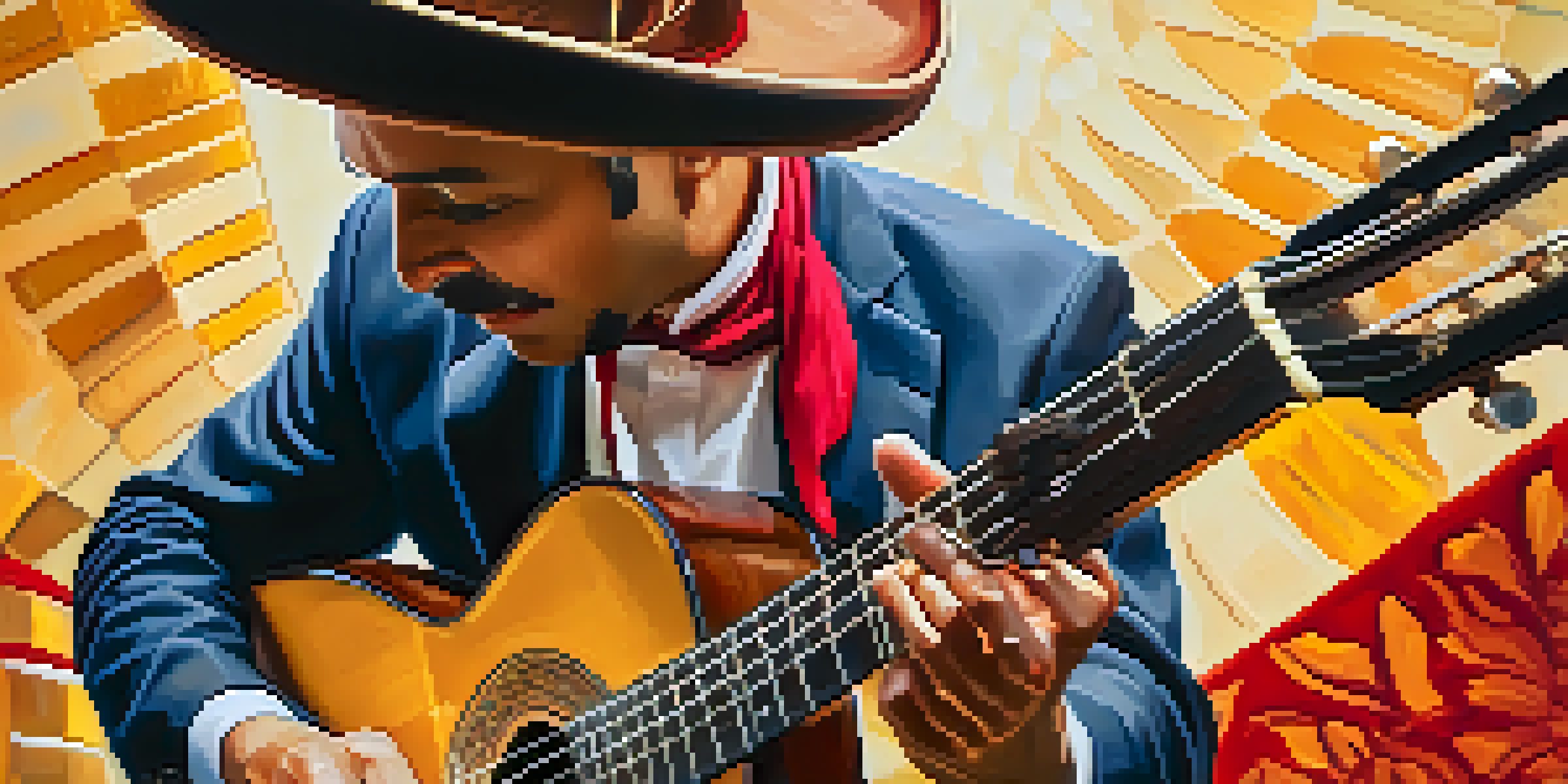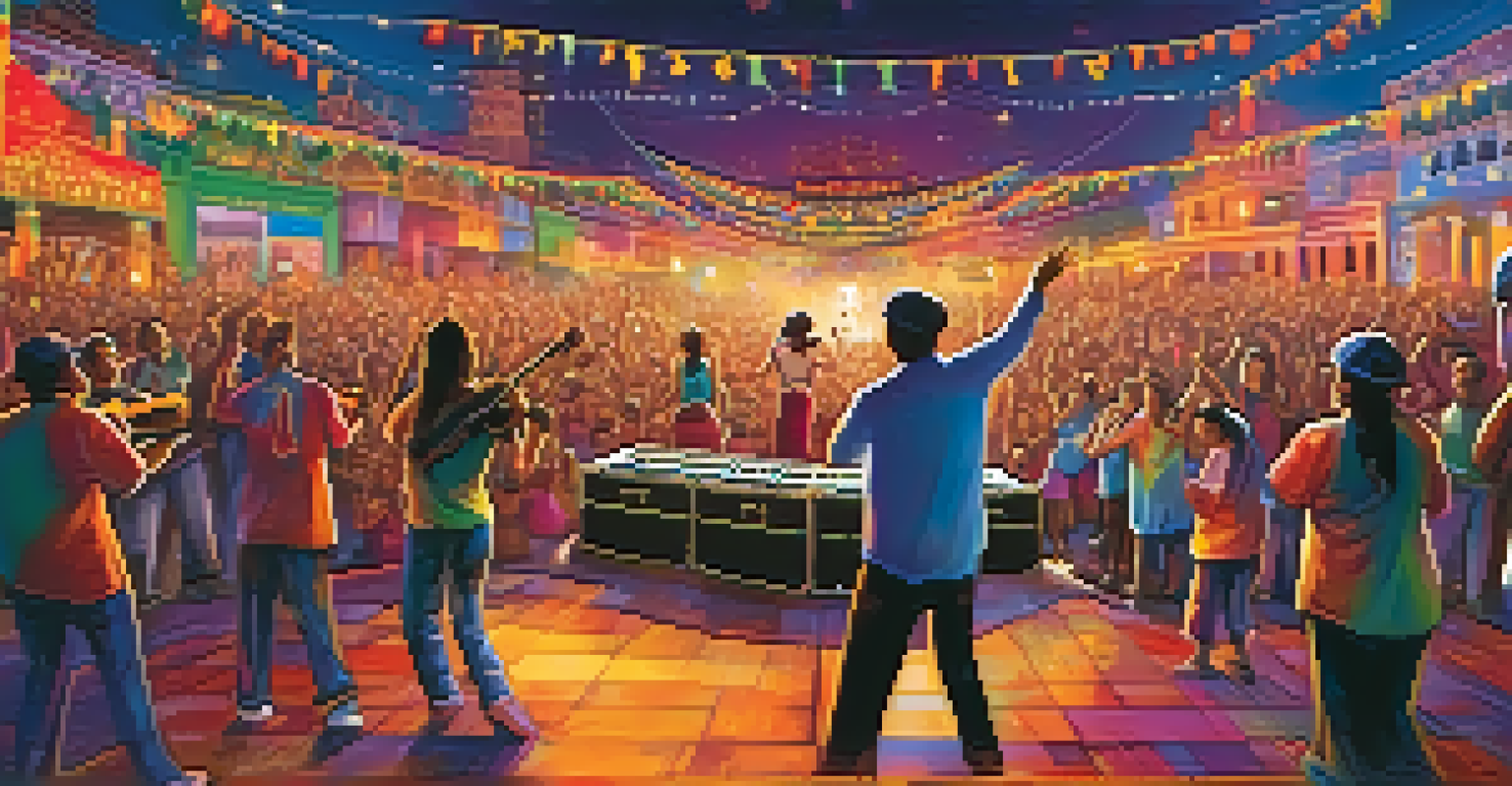Cultural Expressions: Guitar in Traditional Performance Art

The Guitar: A Universal Instrument Across Cultures
The guitar has transcended borders, becoming a symbol of cultural identity in various regions. From the flamenco rhythms of Spain to the vibrant strumming in Latin America, the guitar offers a unique voice that resonates with diverse traditions. This versatility makes it a beloved instrument in many traditional performance arts, allowing for a rich tapestry of sounds and styles.
Music is a world within itself, it’s a language we all understand.
In many cultures, the guitar serves as a storytelling tool, weaving narratives through its melodies. For instance, in the traditional folk music of the American South, the guitar often accompanies songs that reflect the struggles and triumphs of everyday life. This connection between music and storytelling is a testament to the instrument's powerful role in cultural expression.
Moreover, the guitar's adaptability means it can blend seamlessly with local instruments, enhancing the overall performance. Whether it's accompanying a solo dancer or joining a full ensemble, the guitar's influence can be felt in various musical genres, highlighting its significance in cultural traditions worldwide.
Historical Roots of the Guitar in Performance Art
The history of the guitar is as diverse as the cultures it represents, with roots tracing back to ancient stringed instruments. Over centuries, it evolved into the six-stringed guitar we know today, influenced by various musical styles and traditions. This historical journey enriches its presence in performance art, showcasing how it has adapted to meet the needs of artists across generations.

In many traditional performances, the guitar is not just an instrument but a cultural artifact that carries the weight of history. For example, in Spanish flamenco, the guitar is integral to the performance, reflecting the passionate spirit of the culture. Each strum and pluck narrates stories that have been passed down through generations, making the guitar a key player in preserving cultural heritage.
Guitar: A Cultural Connector
The guitar serves as a universal instrument that bridges cultural identities and narratives across various traditions.
Understanding the historical context of the guitar enhances our appreciation of its role in performance art. It allows us to see the connections between past and present, recognizing how traditional forms continue to influence modern interpretations and styles.
Guitar Techniques in Traditional Performance Arts
Guitar techniques vary widely across cultures, each bringing a unique flavor to traditional performance arts. Fingerpicking, strumming, and tapping are just a few examples of the techniques that musicians employ to create intricate melodies and rhythms. These techniques are not just skills; they are expressions of cultural identity and personal style.
The guitar is a miniature orchestra in itself.
Take the Brazilian bossa nova, for instance, where the guitar’s soft, syncopated rhythms create a laid-back atmosphere. The way musicians incorporate their cultural influences into their guitar playing is fascinating, showcasing the instrument's versatility. Each technique serves a purpose, whether to evoke specific emotions or to engage the audience in a communal experience.
Moreover, the learning of these techniques often involves oral tradition, where knowledge is passed down from master to student. This practice not only preserves the techniques but also strengthens community bonds, as musicians gather to share their love for the guitar and the stories it tells.
The Guitar's Role in Cultural Festivals
Cultural festivals around the world often showcase the guitar as a central element of traditional performance art. These events provide a platform for musicians to celebrate their heritage, engage with audiences, and pass on their cultural traditions. The vibrant sounds of the guitar fill the air, creating an atmosphere that is as much about community as it is about music.
At festivals, the guitar acts as a bridge between different generations, allowing older artists to mentor younger musicians. This intergenerational exchange is crucial for keeping traditions alive. For instance, at a traditional Irish festival, you might see a seasoned guitarist teaching a young child how to play folk tunes, ensuring that the cultural legacy continues.
Preserving Heritage Through Music
Musicians use the guitar to transmit cultural history and values, ensuring traditions thrive in a globalizing world.
Additionally, these festivals often feature collaborations between artists from different backgrounds, resulting in innovative performances. The guitar’s adaptability allows it to blend seamlessly with various musical styles, fostering creativity and cultural exchange in the process.
Impact of the Guitar on Modern Cultural Expressions
As time progresses, the guitar continues to evolve, influencing modern cultural expressions while maintaining its traditional roots. Contemporary musicians often blend traditional guitar styles with modern genres, creating a unique fusion that resonates with new audiences. This evolution demonstrates the guitar's ability to adapt and thrive in an ever-changing musical landscape.
For example, many modern pop and rock artists incorporate traditional guitar techniques into their music, paying homage to cultural heritage. This fusion not only brings traditional sounds to the forefront but also introduces them to a younger audience. It’s a beautiful way to celebrate cultural diversity while making it accessible to everyone.
The guitar also plays a pivotal role in social movements, where music becomes a tool for change. Artists use their platform to address issues such as identity, inequality, and cultural pride, with the guitar serving as a powerful medium for expression. This shows that the guitar is not just an instrument; it is a voice for the voiceless.
The Emotional Connection of the Guitar in Performance
One of the most compelling aspects of the guitar is its ability to evoke deep emotions during performances. Musicians can convey joy, sorrow, love, and longing through their playing, creating a profound connection with the audience. This emotional resonance is what makes the guitar a favorite in both traditional and contemporary performance arts.
Consider a solo guitar performance at a traditional wedding; the melodies can set the tone for the entire event, reflecting the joy of the occasion. Similarly, in a poignant storytelling performance, the guitar can underscore the narrative's emotional weight, pulling listeners into the tale. This ability to express complex emotions is what elevates the guitar beyond a mere instrument.
Emotional Resonance in Performance
The guitar's ability to evoke deep emotions fosters a profound connection between musicians and their audiences.
Moreover, the intimate nature of guitar playing often invites listeners to engage on a personal level. Whether it’s an acoustic set in a small venue or a grand performance at a festival, the guitar creates an atmosphere of closeness that resonates with audiences, making each experience unique and memorable.
Preserving Cultural Heritage Through Guitar Music
The preservation of cultural heritage is a vital aspect of the guitar's role in traditional performance art. Musicians are often seen as custodians of their culture, using the guitar to transmit history, values, and stories to future generations. This responsibility adds depth to their artistry, as they strive to keep their traditions alive in an ever-globalizing world.
Many communities actively engage in efforts to document and promote traditional guitar music, ensuring that it does not fade into obscurity. Workshops, festivals, and educational programs play a crucial role in this preservation effort, encouraging young musicians to explore their cultural roots. By learning and performing traditional pieces, they contribute to the ongoing legacy of guitar music.

Additionally, the rise of digital platforms has made it easier for traditional guitar music to reach a global audience. Musicians can share their cultural expressions online, transcending geographical barriers and fostering appreciation for diverse musical traditions. This digital age presents a unique opportunity for the guitar to not only preserve but also innovate within traditional performance art.